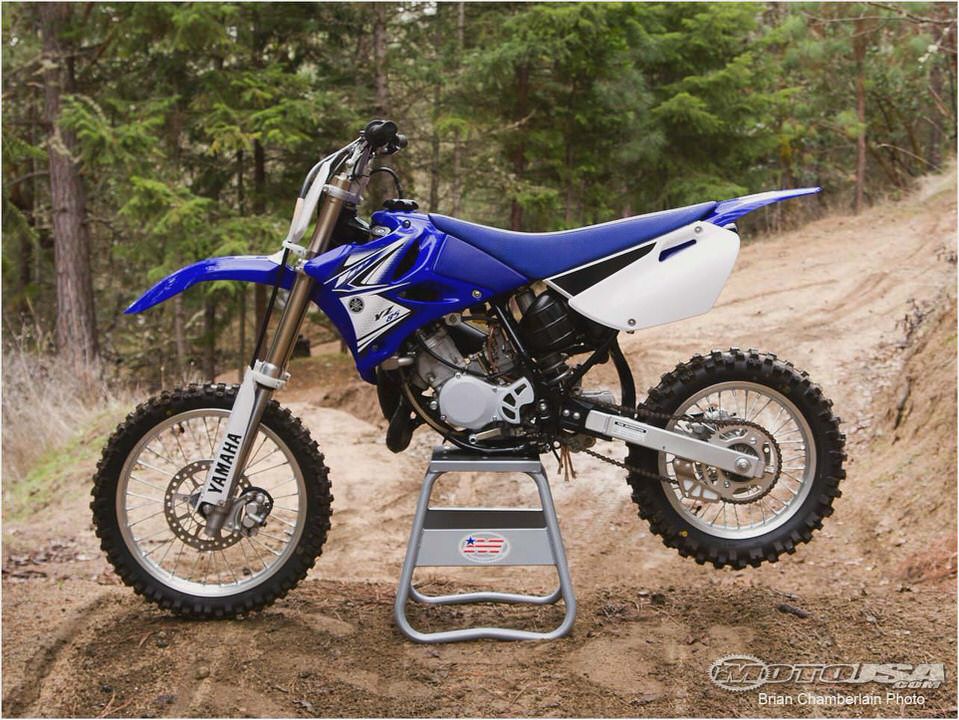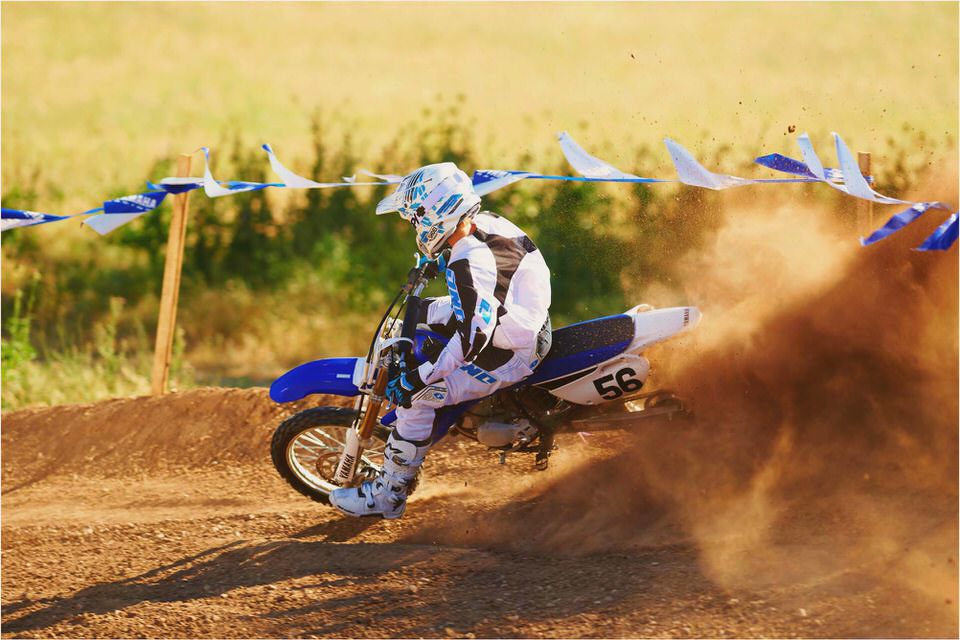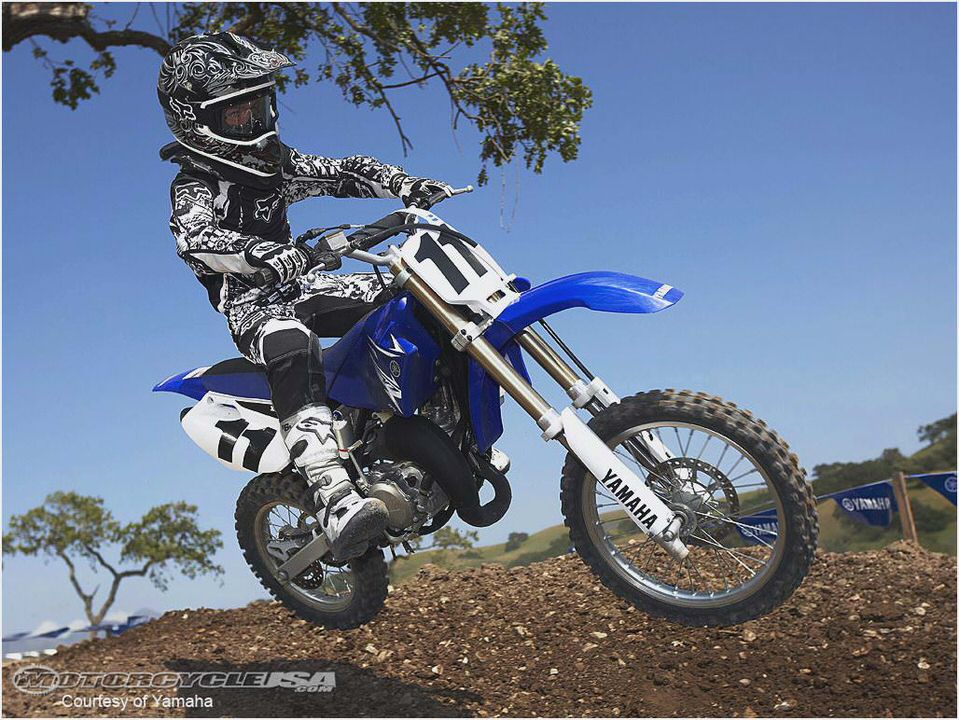
2011 Yamaha YZ85 First Ride
Watch the YZ85 and hear it scream around the track in our 2011 Yamaha YZ85 First Ride Video .
I was only 10 years old, but I can still remember like it was yesterday. My dad and I made a trip to the local Yamaha dealer to pick up some parts for my five-year-old YZ80. As we entered the store I was instantly drawn to a lineup of shiny 1982 YZ’s. I quickly made my way down the row of bikes, skipping past the 490, then the 250, past the 125 and finally to the new YZ80.
The bike was light-years ahead of my current ride. It featured a mono-shock swingarm, liquid cooling via a small radiator behind the front number plate, a seat that actually carried up onto the tank and was decked out with black number plates all sporting a big #1. The bike was at the forefront of mini technology and was the ride of choice for all of the fast kids who were dominating the mini class.
I could have sat and stared at that bike for hours on end. For months I would dream about owning it, but a new bike was not in our budget and I would have to wait quite a while, almost 30 years, for a brand new YZ80 to show up in my garage.
I finally have a 2011 YZ85 sitting in my garage. Unfortunately, I am now way too old and too large to relive my youth, but at least I get to watch my own son put the little YZ through its paces. A lot has changed in all those years but one thing still remains the same; the YZ85 is still a serious contender in the mini ranks.
MotoUSA test rider Luke Chamberlain says the YZ85 has plenty of engine power. The trick is learning to ride high in the rpm range.
Engine
For young riders between the ages of 9 and 14 who are looking to make a name in the motocross world, or at least bring home some trophies from the local track, the Yamaha has the engine to do it. The littlest YZ features an 85cc liquid-cooled, crankcase reed-valve-inducted two-stroke engine. The cylinder bore and stroke measure up to 47.5 x 47.8mm with an 8.2:1 compression ratio.
Fuel is fed through a 28mm Keihin flat-slide carburetor and power is put to the ground via a six-speed close-ratio transmission.
While the spec sheet on the 85 is nothing groundbreaking, the performance output is stellar. This bike flat rips, although the lack of a power valve creates a very hard hitting motor with most of the horsepower delivered in the top end, even by 85 standards. In addition to its anemic bottom end and midrange power, the YZ comes with very tall gearing which makes it even more difficult to find the power in tight or slow speed riding areas.
Beginning riders could become frustrated trying to keep it in the powerband, but aggressive riders who can ride at the top of the rev range will be very satisfied with the results.
We tested at a variety of MX tracks resulting in mixed engine feedback from our 12-year-old, 90 pound test rider, Luke Chamberlain. Our first testing location was a very tight track with lots of steep elevation changes.
“I had a hard time getting used to the power and had to really slip the clutch a lot to get it to pull out of the tight corners and up the hills,” said Luke after the first session. The tall gearing also took a little time to get used to. “I had to run a gear lower than on my current 85 in all of the turns in order to keep it in the powerband.” By the end of the day he had figured out the new shifting points and got a better feel for the power delivery. I could tell his initial areas of frustration were diminishing and he was starting to really enjoy the new Yamaha.
As we were getting ready to load up at the end of the first day, the track owner, and local pro, Devin Watson, asked if he could take the YZ out for a quick spin. While he was a little big for the bike, I was curious to get the feedback from someone of his riding level. During the first lap I could hear a lot of clutch fanning, but by the second lap all I could hear was a screaming two-stroke echoing through the hills.
After a few laps he pulled back in with a big grin on his face. “Man, this thing feels as fast as some of the 125s I was riding just a few years back!” That sounded like a pretty good endorsement to me.
The YZ uses a single left-side radiator shroud. Wider, faster tracks suit the Yamaha’s stock gearing and power delivery.
Our next two test tracks featured a more typical motocross layout with some higher speed corners and long, fast straights. Luke came away with a much better appreciation for the motor at these venues. “It was much easier to keep it in the power on the big tracks. I was able carry a lot more corner speed and keep the revs up much easier. It was really fast down the straightaways.”
The transmission performed flawlessly without any missed shifts or false neutrals. While the final drive is a little tall for some locations, the internal gear ratios seem well suited. The clutch is smooth, although the lever pull is a little stiffer than Luke would prefer.
The clutch engages at the end of the lever which makes quick fanning easy to do without having to pull the lever all the way back to the bars.
Even with slightly stiff suspension for our test rider, the YZ85 is a great jumper.
Chassis / Suspension
The YZ uses a single-backbone, semi-double-cradle steel frame. The rear subframe is removable to allow easy maintenance and cheaper replacement cost. Ergonomics are roomy enough for taller kids to remain comfortable and the seat is very flat and fairly stiff, allowing the rider to easily slide up on the front for cornering. Handlebars are tall in relation to the seat and with a seat height of 34 inches, taller kids will feel the most comfortable on the Yamaha.
Unlike its larger siblings that use ProTaper bars, the 85 comes stock with steel bars that are very susceptible to bending during a crash. The bike is very slim with the single left-side radiator tucked in nice and tight. The right side uses an extended fuel tank to compensate for the lack of radiator.
While still pleasing to look at, the missing right shroud also saves the hassle of having to deal with, or replace a cosmetic shroud.
The front suspension is handled by 36mm Kayaba inverted cartridge fork. They offer 10.8 inches of travel and have fully adjustable compression and rebound dampening. Outer tubes and internals are low-friction for a smoother stroke.
Out back is a Kayaba shock providing 11.1 inches of travel. Just like the fork, the shock has fully adjustable compression and rebound.

Our tester stands at 5’2” and found the YZ very comfortable for his size. It looks like the YZ still has a little room left for that next growth spurt. With Luke weighing in at a scant 90 lbs. the springs are borderline on the stiff side. We try to set rider sag in the 95mm – 105mm range on 85’s with free sag ending up in the 25mm -45mm range. On the YZ, setting rider sag resulted in a little too much free sag.
Slightly softer springs would get the settings more in line with where we typically run, but Luke liked the stiffer preload when landing big hits better than the setup on his own bike.
Features and Maintenance
While there is no groundbreaking technology appearing on any of the 85’s these days, Yamaha has continually refined the littlest YZ into a well thought out and competitive race package. There are also a few little details that most mini dads will appreciate. The airbox opening is fairly roomy and the filter is easy to install, both on the cage, as well as into the airbox. The chain adjusters are very easy to use and are easily readable for precise adjustments.
Both of these little features go a long way in simplifying the maintenance required on the bike. They also enable young riders to learn these tasks without the worry of getting something wrong, like improperly installing an air filter and cross threading the air filter bolt. The clutch cover also uses a two-piece design for quick and easy access to the clutch.
What We Would Change
Riders will have some room to grow with the tallish YZ. We can teach basic maintenance to the kids with easy airbox and chain guide access. The stock handlebars will bend in the smallest tip-over and need to be replaced.
The YZ85 is a ripping race bike right out of the crate. The fully adjustable suspension works well without modification, with the only exception being that of getting the proper spring rate. The motor has plenty of muscle and it just becomes a matter of getting it dialed in for the track you are riding.
If we were to race this bike on our typical tracks I would add a couple teeth to the rear sprocket (47 stock) to give it a little more grunt out of corners. I would also be interested to see if an aftermarket pipe and possibly a VForce reed block would add any usable power to the midrange without sacrificing too much of the awesome power on top. Playing with the ignition timing may also add a little more usable power down low.
Other changes would be small component swaps. The bars would be the very first item to get swapped out, as they are a big liability, even in the simplest of crashes. Break-away levers are always a great idea for any race bike, especially one ridden by crash-prone youngsters. The pegs on the 85 are not like the big, wide ones that come on the larger YZ’s and we’d upgrade to a wider peg as well.
The stock Dunlops work on harder terrain but lacked the lugs needed for anything on the softer side. All of these are simple aftermarket upgrades that most racers would make regardless of the bike.
Final Thoughts
With quite a few days spent on the YZ, our tester is really falling in love with the power of the little 85. While it took a bit to get used to the top-end bias, he has adapted well to the engine characteristics. The roomy ergos fit him well and allow a little room to grow. He really likes jumping the YZ and is very impressed with how well it soaks up any hard landings.
The only problem at this point will be telling him the test is over and we have to give the bike back to Yamaha. Looks like I might have to start saving up.




- Building a Go-Far Yamaha FJR1300AE- Endurance Rally Motorcycles
- Bajaj Pulsar 150cc DTSi vs Yamaha 153cc FZ 16 comparison
- Specifications for a Yamaha RD350 eHow
- 2012 Yamaha YZF-R1 WGP 50th Anniversary motorcycle review @ Top Speed
- 2006 Yamaha YZF-R1SP Motorbikes
